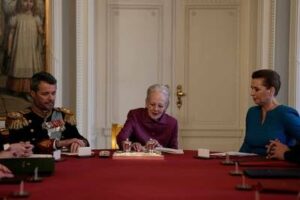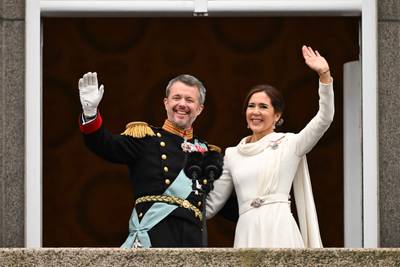Queen Margrethe of Denmark has abdicated the throne, ending her 52-year reign as her son, Prince Frederik, ascends to become King Frederik X.
Gatekeepers News reports that the Queen signed a declaration of abdication after a final procession in a horse-drawn carriage through the streets of Copenhagen to Christiansborg Palace, the seat of government and parliament.

This abdication is a first in 900 years in Denmark, ending her 52-year reign – only the second time a Danish sovereign has stepped down, the last one Erik III almost nine centuries ago in 1146.
Her 55-year-old son Frederik – who also attended the Council of State along with his Australian-born wife Mary and their eldest child, 18-year-old Prince Christian – automatically became king and head of state upon Margrethe’s abdication.

Prime Minister Mette Frederiksen then proclaimed him King Frederik X on the balcony of Christiansborg Palace.
Australian-born Mary is the first commoner to become queen in Denmark.
Hotels and rail and airline tickets have been fully booked since the queen dropped her bombshell abdication announcement in her annual televised New Year’s Eve address.
In close-to-freezing temperatures, tens of thousands of people from all over Denmark converged on the capital to witness the events, in a sign of the huge popularity the monarchy enjoys in the nation of nearly six million.
“The last time, in 1972 (when Margrethe became queen after the death of her father), there were more than 10,000 people on the square below. We’re expecting more this time,” historian Lars Hovbakke Sorensen said in an interview with AFP.
“We have come here today because this is history being made in front of our eyes. We just had to be here,” said Soren Kristian Bisgaard, 30, a pilot.
Later in the afternoon, the new king and queen rode on a horse carriage back to their residence, Amalienborg, a royal complex built in the 1750s and located in central Copenhagen.

The couple will continue to reside with Margrethe in Amalienborg albeit in their respective palaces in the octagonal complex.
Margrethe will retain her title of queen and may represent the royal family on occasion
Apart from the abdication, the protocol is largely similar to previous royal successions in Denmark. No foreign dignitaries or royals are invited, and there is no coronation or throne for the new monarch.
Margrethe chose to abdicate exactly 52 years to the day after she took over from her father, Frederik IX.
The queen’s abdication announcement stunned Danes, after she had repeatedly insisted she would follow tradition and reign until her death. Even her own family was only informed three days prior.
She attributed her decision to health issues after undergoing major back surgery in February last year.
The Danish royal couple will take the throne at a time of huge public support and enthusiasm for the monarchy.
About two-thirds of the Danes have never lived under another monarch, so the succession marks a major shift as they welcome a head of state who could not be more different from his mother.
King Frederik is expected to bring his own style to the monarchy. While his mother is known for her love of the arts and is an accomplished writer and artist, Frederik is an avid sportsman who champions environmental causes.
Frederik is passionate about sports, physical activity and rock music, while Queen Margrethe is interested in archaeology, painting and classical music.
He is perceived as informal and approachable, while she is seen as intellectual, articulate and cultured. Royal observers have argued that his more down-to-earth character could strengthen the Danish monarchy.
“Queen Margrethe II is a woman of her time and Frederik also lives in his own era. He understood that he could not copy her and has managed to define his own image, his own ties to the Danish people,” another historian, Bo Lidegaard, told AFP.
“We will have a different type of monarch, much more informal in his way of speaking with people when he travels across the country,” his colleague Hovbakke Sorensen added.
In Denmark the monarch’s role is largely ceremonial, but he or she does sign legislation, formally presides over the forming of a government and meets with the cabinet regularly.








